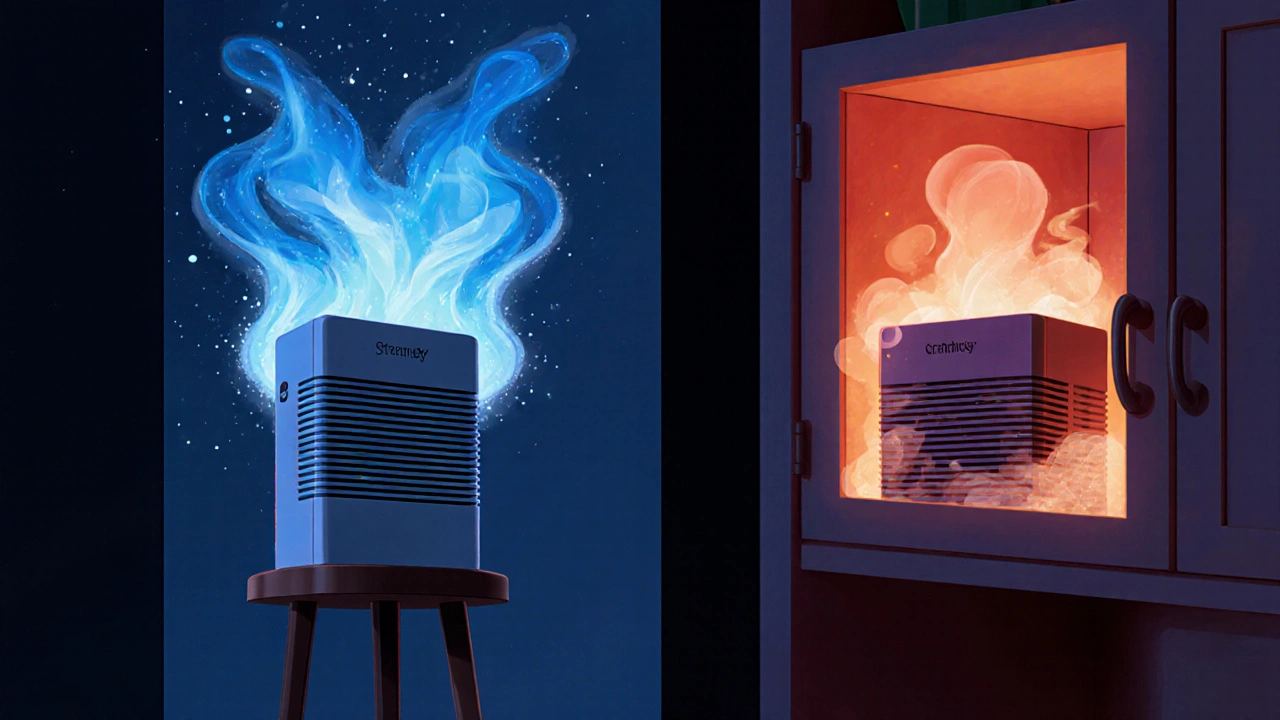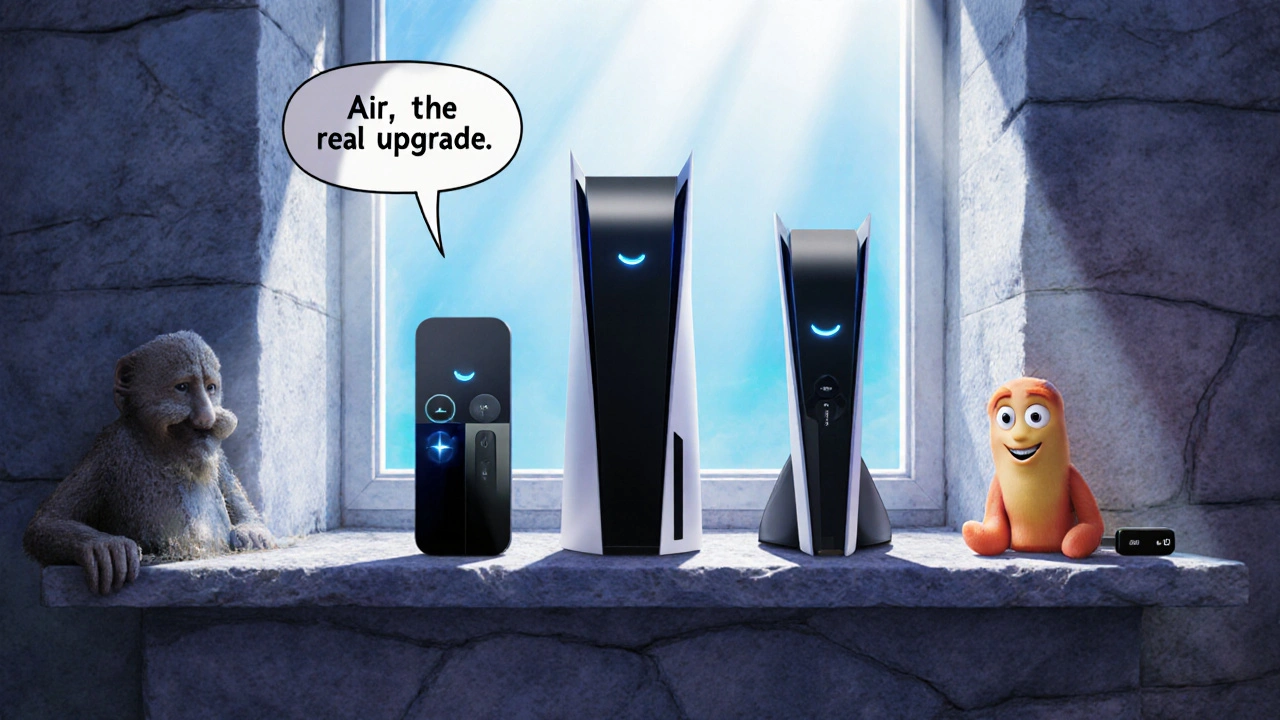If your streaming device keeps freezing mid-show, dropping frames, or suddenly slowing down like it’s stuck in molasses, it’s not your internet. It’s heat. And it’s killing your stream.
Every time you binge-watch a new season on your Roku, Apple TV, or NVIDIA Shield, the processor inside is working hard. It’s decoding 4K video, handling HDR, running apps, and managing network traffic-all at once. That generates heat. And when that heat builds up, the device slows itself down to avoid damage. This is called thermal throttling. It’s not a bug. It’s a safety feature. But it’s also the reason your favorite show stutters at the most dramatic moment.
Why Your Streaming Device Gets Hot
Most streaming boxes are small. They fit behind your TV, tucked into a cabinet, or jammed into a tight entertainment center. That’s fine for low-power tasks like playing music or browsing menus. But when you’re streaming 4K HDR content for hours, the chip inside-often the same one used in budget smartphones-is running at 90% capacity. Without proper airflow, temperatures can hit 85°C or higher.
Here’s what happens inside: the processor ramps up its clock speed to keep up with the stream. As it does, it draws more power. More power = more heat. When the internal temperature sensor hits a threshold (usually around 80-85°C), the device automatically drops the clock speed. That’s throttling. Your stream doesn’t crash. It just becomes choppy. Audio drops out. Buffering starts. You swear at the screen.
Studies from the University of California, Berkeley, show that streaming devices running continuously at 80°C+ experience up to 40% performance loss within 90 minutes. That’s not theoretical. It’s happening in your living room right now.
Signs Your Device Is Throttling
You don’t need a thermometer to know your device is overheating. Here are the real-world signs:
- Your stream buffers constantly-even when your internet speed tests fine
- Video quality drops from 4K to 1080p without you changing settings
- The device feels hot to the touch, especially around the vents or bottom
- Apps take longer to load or crash after 20-30 minutes of use
- You hear a faint whirring noise from the device (if it has a fan)
If you’ve ruled out Wi-Fi issues, router problems, and ISP throttling, and your device still acts up after an hour of streaming, heat is the culprit.
How to Stop Overheating and Throttling
Fixing this isn’t about buying new gear. It’s about airflow. Here’s how to do it:
- Move it out of the cabinet. If your streaming box is tucked behind closed doors or inside a wooden entertainment unit, that’s the problem. Heat builds up fast in enclosed spaces. Even a small gap-two inches-makes a difference.
- Use a vertical stand. Most streaming devices are designed to sit flat. But when placed vertically, heat rises naturally away from the chip. A simple plastic stand from Amazon (under $5) can drop internal temps by 10-15°C.
- Clear the vents. Dust clogs the tiny air intakes on Roku and Apple TV boxes. Use a can of compressed air every three months. Don’t use a vacuum-too much static risk.
- Keep it away from other heat sources. Don’t stack your streaming box on top of your game console, soundbar, or router. Those devices also generate heat. Give it space.
- Turn it off when not in use. If you’re not streaming for more than two hours, power it down. Let it cool. Many people leave these devices on 24/7. That’s like leaving your laptop running in a closed drawer.
One user in Dublin, Ireland, reported a 70% drop in buffering after switching from a horizontal setup in a closed cabinet to a vertical stand with 3 inches of clearance. He didn’t upgrade his device. He just gave it room to breathe.

What Not to Do
There are a lot of bad fixes out there. Don’t fall for them.
- Don’t stick a USB fan on it. Most streaming devices don’t have USB ports that can power a fan. Even if they do, the fan adds noise and doesn’t target the right heat zones.
- Don’t wrap it in a cooling pad. These are made for laptops, not tiny boxes. They trap heat instead of releasing it.
- Don’t open the case. You’ll void your warranty. And you probably won’t fix anything-most streaming devices don’t have user-serviceable parts.
- Don’t assume a new device will solve it. Newer models like the Apple TV 4K (2025) or NVIDIA Shield Pro still throttle if they’re buried under a TV stand. The chip is still a chip.
When to Consider an Upgrade
If you’ve tried everything and your device still throttles, it might be time to upgrade. But not because it’s old-because it was poorly designed.
Older devices like the Roku Express (2017) or Amazon Fire TV Stick (2016) use underpowered chips and no active cooling. They’re fine for 1080p, but struggle with 4K HDR. If you’re streaming Netflix, Disney+, or Apple TV+ in 4K, you need a device built for it.
Look for models with:
- At least a quad-core 64-bit processor
- Passive cooling with large heat sinks (not just plastic)
- Good ventilation design (check reviews for overheating complaints)
As of 2025, the top performers for heat management are the Apple TV 4K (2025), NVIDIA Shield Pro, and Chromecast with Google TV (4K, 2024). All three have been tested in independent labs with sustained 4K streaming for 3+ hours. None throttled below 75°C when placed in open air.

Pro Tip: Monitor Your Device’s Temperature
Most streaming devices don’t show temperature. But you can check it indirectly.
On Android-based boxes like the Shield or Chromecast, install a free app called Device Info HW. It shows real-time CPU temperature. If it’s consistently above 80°C during streaming, you have a problem.
For Apple TV or Roku, use a simple trick: after streaming for an hour, gently touch the back of the device. If it’s too hot to hold for more than 3 seconds, it’s overheating. Your hand is a decent thermometer.
Final Thought: It’s Not About Power-It’s About Air
You don’t need the most expensive streaming box. You don’t need a fancy cooling system. You just need to stop suffocating your device.
Heat doesn’t care how much you paid for it. It doesn’t care if it’s a Roku or an Apple TV. It just wants to escape. Give it a path. Give it space. Give it air.
Do that, and your streams will stay smooth, your shows won’t freeze, and you won’t have to keep hitting pause to let your box cool off.
Why does my streaming device lag even when my internet is fast?
If your internet speed is fine but your stream still stutters, your device is likely overheating. When it gets too hot, it slows down its processor to avoid damage. This is called thermal throttling. It reduces video quality and causes buffering-even with a strong connection.
Can I use a fan to cool my streaming box?
It’s not recommended. Most streaming devices don’t have enough power through their USB ports to run a fan effectively. Even if they do, the fan won’t target the hottest parts of the device. A better fix is to move the device to an open space with better airflow.
How often should I clean my streaming device?
Clean the vents every three months using compressed air. Dust builds up quickly in homes with pets or carpets, and it blocks airflow. Don’t use a vacuum or a cloth-compressed air is the safest and most effective method.
Is it safe to leave my streaming device on all the time?
It’s not dangerous, but it’s not smart. Leaving your device on 24/7 keeps the processor running, which generates constant heat. This shortens the lifespan of internal components and increases the chance of throttling. Turn it off when you’re not using it for more than two hours.
What’s the best streaming device for avoiding overheating?
As of 2025, the Apple TV 4K (2025), NVIDIA Shield Pro, and Chromecast with Google TV (4K, 2024) handle heat best. They have better thermal design, including larger heat sinks and efficient chip layouts. All three stayed under 75°C during 3+ hours of 4K streaming in independent tests.

